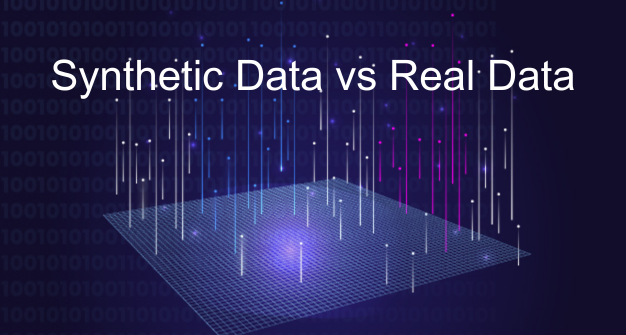
In the realm of artificial intelligence (AI) development, data is the lifeblood that fuels the algorithms, models, and applications we rely on. However, there is an ongoing debate about whether synthetic data or real data is the better choice. Each type has its own set of advantages and limitations. In this article, we will undertake a comparative analysis of synthetic data and real data to help you understand their respective roles in AI development.
What is Synthetic Data?
Synthetic data is artificially generated data that simulates real-world data. It is created through various techniques, including data augmentation, generative models, and other data generation methods. Synthetic data generation is the process of creating artificial data that mimics real-world data but is not derived from actual observations.
What is Real Data?
Real data, as the name implies, is data collected from the real world. It includes information from sensors, surveys, social media, and a multitude of other sources. Real data is often seen as more valuable because it reflects actual conditions and behaviors in the world. However, it can be limited in terms of quantity and quality.
Advantages of Synthetic Data
- Privacy and Security: One of the most significant advantages of synthetic data is that it can be used without exposing sensitive or personal information. This is especially important in industries such as healthcare and finance, where privacy regulations are strict. Synthetic data enables AI researchers and developers to test and fine-tune algorithms without violating privacy rules.
- Ample Supply: Generating synthetic data is often easier and less expensive than collecting large volumes of real data. This can be particularly advantageous when dealing with rare or unique scenarios that are hard to capture in real data.
- Balanced Datasets: In the real world, certain classes or categories of data may be underrepresented or overrepresented, leading to biased models. Synthetic data can help create balanced datasets, which can improve the performance and fairness of AI models.
- Data Augmentation: Synthetic data can be used to augment real data, thereby increasing the size of the dataset for model training. This can lead to better generalization and performance.
Limitations of Synthetic Data
- Generalization Challenges: Synthetic data might not always accurately capture the complexities of the real world. Models trained on synthetic data may not generalize well when applied to real-world scenarios.
- Quality and Fidelity: The quality of synthetic data heavily relies on the algorithms and techniques used to generate it. Poorly generated synthetic data can lead to suboptimal AI models.
- Ethical Concerns: There can be ethical concerns about using synthetic data to develop AI systems. If the synthetic data does not adequately reflect the diversity and characteristics of the real world, it can lead to biased models.
Advantages of Real Data
- Ground Truth: Real data provides an accurate representation of actual conditions, behaviors, and events in the real world. It is considered the gold standard for training AI models.
- Real-World Application: Models trained on real data are more likely to perform well in real-world scenarios. This is crucial for applications such as autonomous vehicles, medical diagnosis, and financial predictions.
- Research Validation: Real data is essential for validating the results of AI research and ensuring that algorithms work as intended in practical applications.
Limitations of Real Data
- Privacy Concerns: Gathering real data often involves collecting personal and sensitive information, raising privacy concerns and potential legal issues.
- Scarcity: In some cases, obtaining a sufficient amount of high-quality real data can be challenging and expensive, especially for emerging or niche fields.
- Data Bias: Real data may be inherently biased due to historical inequalities and underrepresentation of certain groups, leading to biased AI models.
The Complementary Approach
Rather than viewing synthetic and real data as competitors, many AI developers now see them as complementary tools. Combining the strengths of both can lead to more robust and ethical AI development. Here’s how they can work together:
- Pre-training with Synthetic Data: Start with synthetic data to pre-train models, and then fine-tune them with real data. This helps create a strong foundation while adapting to real-world nuances.
- Data Augmentation: Use synthetic data to augment real data, thereby increasing dataset size and diversity.
- Privacy and Security: When handling sensitive information, replace real data with synthetic data, allowing developers to work on AI models without exposing confidential details.
Conclusion
In conclusion, the choice between synthetic data and real data for AI development depends on the specific use case, the availability of data, and privacy considerations. While synthetic data offers advantages in terms of privacy, supply, and balanced datasets, it can struggle with real-world generalization. Real data, on the other hand, provides the gold standard in terms of accuracy and real-world performance but may be limited in quantity and raise privacy concerns.
The smart approach is to use both synthetic and real data strategically, leveraging their respective strengths to develop more robust and ethical AI systems. This hybrid approach represents the future of AI development, where data diversity and privacy can coexist with real-world performance and accuracy.

![How to Pause Location on Find My iPhone Without Them Knowing? [2024] 16 how to pause location on find my iphone](https://izood.net/wp-content/uploads/2024/10/How-to-Pause-Location-on-Find-My-iPhone-Without-Them-Knowing-400x300.png)


![How To Inspect Element on iPhone [4 Methods] 19 how to inspect element on iphone](https://izood.net/wp-content/uploads/2024/10/how-to-inspect-element-on-iphone-3-400x300.png)


